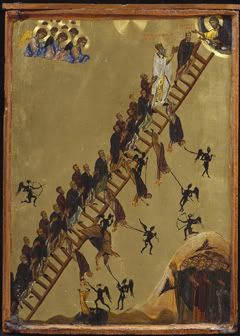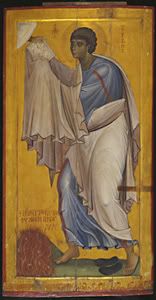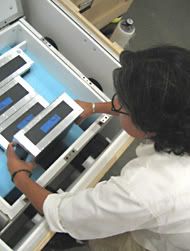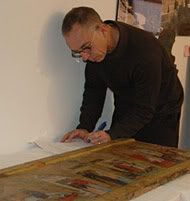
The Heavenly Ladder of Saint John Climacus, late 12th century, The Holy Monastery of Saint Catherine, Sinai, Egypt
Holy Image, Hallowed Ground: Icons from Sinai (November 14, 2006–March 4, 2007 at the Getty Center)
This exhibition offers an unprecedented look at some of the oldest surviving icons from the Byzantine world, and provides rare insight into monastic life, past and present, at the remote Holy Monastery of Saint Catherine.
Lying in the shadow of Mount Sinai in Egypt, the Holy Monastery of Saint Catherine is the world's oldest continuously operating Christian monastery. Since the third century, monks have resided here, at the foot of the mountain where Moses is said to have encountered God. The present church and monastery walls were commissioned by the Byzantine emperor Justinian, who ruled over most of the Mediterranean region, including the Sinai peninsula, between 527 and 565.
Fifty-three objects have traveled from the monastery in Sinai for this exhibition. All were either commissioned by the monastery or received as gifts and have remained in the continuous care of generations of monks at Saint Catherine's.
Because of its geographic and political isolation from the Byzantine Empire, the monastery escaped the destruction of religious images that was sanctioned by Byzantine emperors during the period of Iconoclasm in the 700s and 800s. The veneration of icons continued uninterrupted at Sinai, and over the centuries the monastery both commissioned and received as gifts numerous icons, manuscripts, and liturgical objects.
Today, Saint Catherine's monastery is the world's largest repository of Byzantine icons. The works on display underscore the icon's central role in religious practice and introduce the public to the compelling history of Saint Catherine's.

Moses Receiving the Law Before the Burning Bush, about 1050–1100, The Holy Monastery of Saint Catherine, Sinai, Egypt. This icon depicts Moses receiving the Ten Commandments on Mount Sinai. The Burning Bush, seen at his feet, grows within the walls of Saint Catherine's monastery.
The Icons' Journey from Egypt to Los Angeles
Many of the 52 precious objects in the exhibition Holy Image, Hallowed Ground: Icons from Sinai left their home at the Holy Monastery of Saint Catherine, the world's oldest continuously operating monastery, for the first time. Over a year of preparation, conservation work, and careful planning went into this logistical feat.
Conservators and curators from the J. Paul Getty Museum worked with the monks of Saint Catherine's to devise innovative ways to protect these treasures on their nearly 8,000-mile journey to Los Angeles.The planning involved careful documentation; close collaboration between the monks, conservators, and preparators; and the building of tailor-made crates and display cases that protect against bumps and vibrations as well as small changes in humidity.
Many of the objects traveled from Sinai for the first time for this exhibition. The icons are painted on wooden panels, which expand and contract with changing humidity. Because they have adapted to the dry desert climate over the centuries, they are especially sensitive to changes in humidity. Sinai is extremely dry, with relative humidity inside the monastery rarely exceeding 30 percent. Los Angeles, although it is located on the edge of a desert, has an average humidity between 65 and 79 percent. Because of this extreme change, Getty conservators took unprecedented measures to keep the objects from Sinai in a stable climate during transport and while they are on display at the Getty Center.
Bringing the Desert to the Getty Center
So how do they do it?

Shipping crates were custom built to carry the objects traveling from Sinai. Each double crate is composed of over 25 layers of materials that provide shock absorption and minimize changes in temperature and humidity.
First, conservators and preparators built special shipping crates for each object. Each crate is composed of more than 25 layers of materials, which provided shock absorption and humidity control while the objects were in transit. Objects have their own cases, which are then placed in a wooden crate. Each crate is then suspended within a second crate, with a layer of air and cylinders made from a special visco-elastic polymer—called Sorbothane—in between them to provide maximum shock absorption. Other layers include various types of foam for insulation and cushioning, aluminum laminate to seal the wood, thermic tape to create a humidity and temperature barrier, and silicon to seal corner joints against humidity.
Second, the Getty's facilities staff used dehumidifiers to temporarily reduce the relative humidity in the Exhibitions Pavilion at the Getty Center during the two-week installation period. Once the objects were removed from their shipping crates and installed in climate-controlled display cases, the relative humidity in the room was returned to the usual 50–55 percent level.
Finally, Getty preparators designed and built climate-controlled display cases for each of the 52 objects. Hidden silica gel packs absorb the moisture from the air in order to keep the humidity within the cases at 27–32 percent humidity. Computerized data loggers in individual cases also take constant humidity readings.
Preparing to Pack

Getty staff traveled to the monastery to examine the objects in preparation for the move. Here, conservator Brian Considine examines a panel painting.
Ready to go? Not quite. Before the artworks could begin the journey, their pre-move condition was recorded in minute detail.
Because many of these objects show signs of their use as ritual objects over hundreds of years, it was important to document their condition before they were moved. This documentation ensured that the objects arrived at the Getty Center in the same condition that they left Sinai. Conservators and preparators traveled to Sinai to study the objects and draw up condition reports, which were kept with the artworks during transit.
Staff working in Sinai took detailed measurements of the objects and sent them back to the Getty Center, where preparators and mountmakers created the custom crates and the mounts for the exhibition.
See also: http://expertmus.livejournal.com/71856.h
http://expertmus.livejournal.com/71501.h


Комментариев нет:
Отправить комментарий